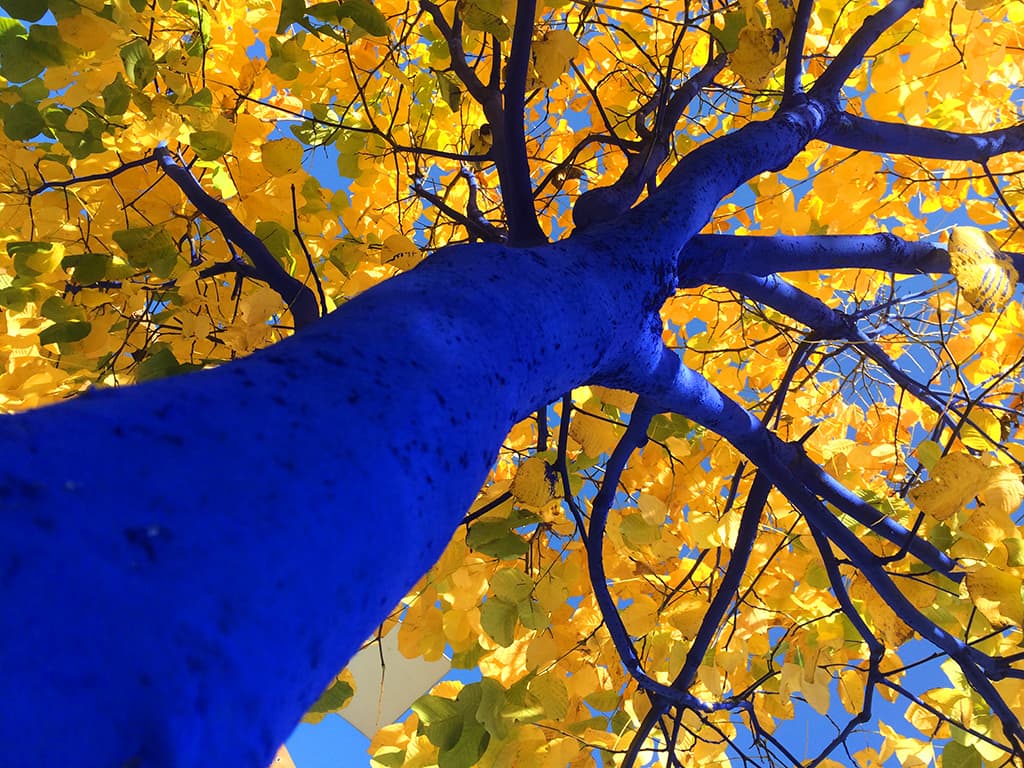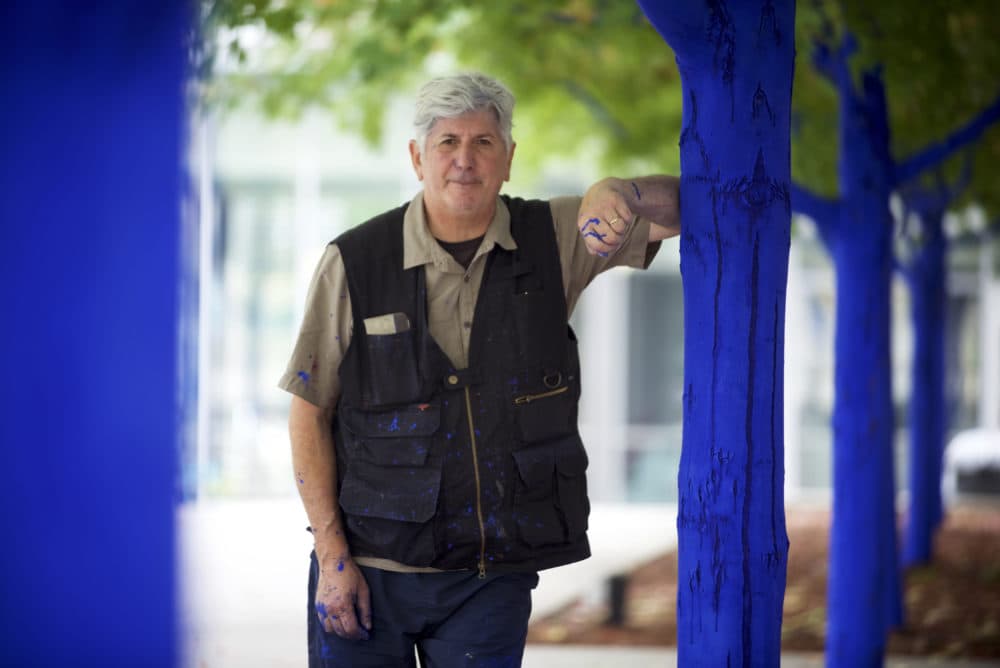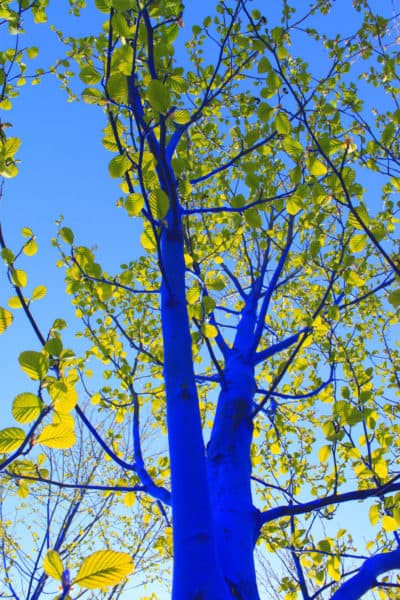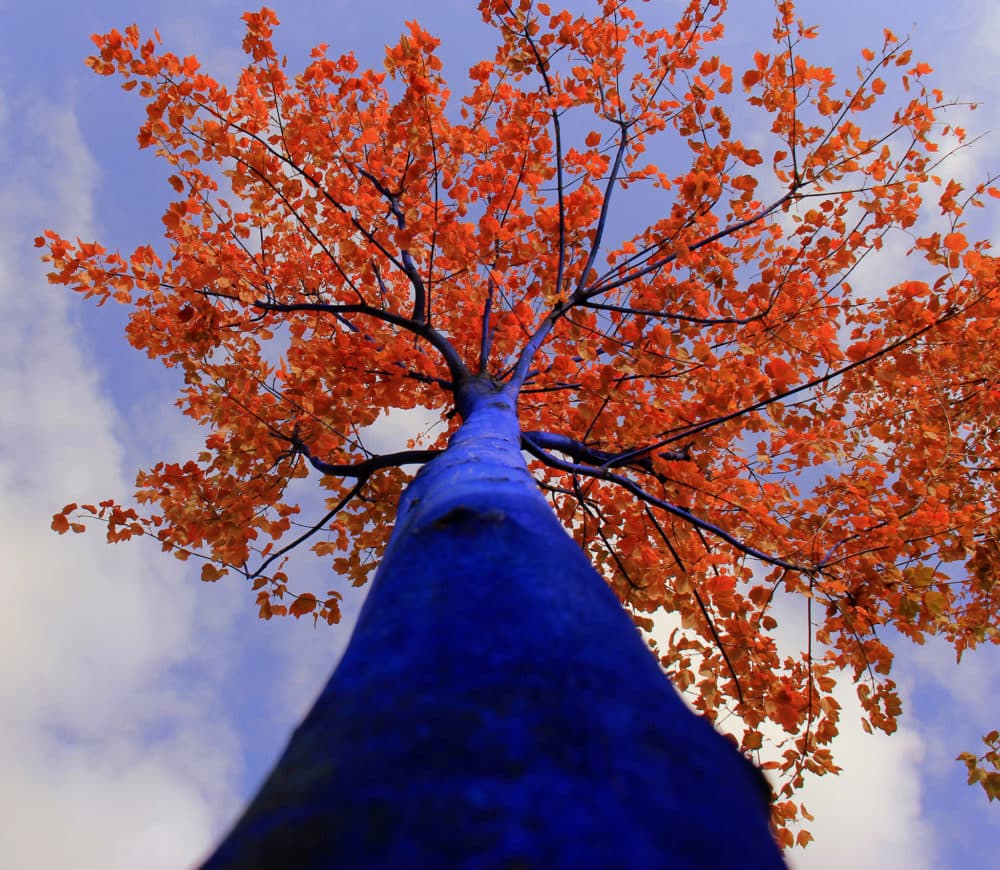Advertisement
At Peabody Essex Museum, trees are turning blue for Earth Day

You pass them every day. But when was the last time you looked at a tree? Appreciated that oak, from fat roots to fine slender limb tips?
You might notice them more if they were electric blue.
That’s the concept behind Australia-based artist Konstantin Dimopoulos’ “The Blue Trees,” going up in time for Earth Day, at Salem’s Peabody Essex Museum.
People are currently taking part in the public art installation. The finished Blue Trees dotting PEM’s campus will be part of their “Climate Action Opening Celebration” on April 23, which also includes exhibition booths and drop-in art-making.
“The Blue Trees” installation is an effort to draw more public awareness to deforestation by coloring trees an eye-catching electric blue. He’s colored trees around the world — including on Cape Cod (2019) and Currier Museum of Art in New Hampshire (2018). This will be the first in the Greater Boston area.

According to PEM’s description, the trees are “an environmental call to action. Using a biologically-safe watercolor and a team of community volunteers, the artist temporarily transforms a selection of trees on PEM's campus to focus our attention on the growing issue of deforestation and other threats to trees around the globe. The harmless blue colorant will wash away over time, and the trees will gradually return to their natural state.”
Because of the pandemic and health issues, PEM says, the artist was not able to oversee the Salem coloring – a term he prefers over “painting,” PEM notes — in person. But PEM and Dimopolouos have found one heck of a substitute to lead the installation in Brooklyn-based artist Wes Bruce, 36.
“Sometimes it takes a burst of color to break people out of their visual white noise,” says Bruce.

Passersby get a wake-up call; painters, meanwhile, appreciate the “poetry” of each tree, Bruce says. “When do you really go out of your way to look at every inch, nook and cranny of tree bark? It gives you the opportunity to revel in the texture.”
A multi-practice artist, educator, poet and designer, Bruce’s bread and butter is creating “large-scale, site-specific installations, exhibitions, and projects that are deeply engaging, exploratory in nature, wildly expansive in imagination and paired with education opportunities.” He’s worked with MASS MoCA, Boston’s ICA and PEM in the past.
“The Blue Trees” first came onto PEM’s radar in 2019 and was supposed to be installed in 2020, but was delayed due to the pandemic.
But the new timing works perfectly, aligning with PEM’s current Climate + Environment Initiative. (Bruce is also part of PEM’s “Climate Action” exhibit, up now.)
Advertisement
“I love that it’s activating people to participate with trees, with the natural world,” Bruce said. “It’s a long-sustained life passion of mine to get people to pay more attention to the world around them, and in turn, to the world within them. [Dimopoulos] has been doing this work for a long time, and seen that this sparks people.”
Dimopoulos was born in Port Said, Egypt to Greek parents and grew up at the mouth of the Suez Canal until age 8, when the family moved to Wellington, New Zealand to escape a political upheaval, his website biography explains.
A conceptual and social artist and sculptor, his art is grounded in sociological and humanist philosophies.
“The important thing is that we get a reaction. People on the whole care about their own trees but don’t understand that the world is interconnected,” Dimopoulos says of “The Blue Trees” over email.
“Color is a powerful stimulant, a means of altering perception and defining space… In nature, color is used both as a defensive mechanism, a means of protection, and as a mechanism to attract. [This] attempts to waken a similar response,” he says. “By asking why are the trees blue, we can then explain their importance to the ecosystems and to our own survival.”
Dimopoulos first started “The Blue Trees” in 2003 as a response “to what I saw as the madness, the absolute craziness of the mass destruction, the deforestation of trees globally and really that this action, this ecocide, was invisible for a large part of the urban population; this invisibility needed to be addressed and made visible.”
One day, while visiting Friends of the Earth in Melbourne, he met someone who had returned from Southeast Asia with “images of huge devastation of forest being burned and cleared. He said to me, ‘I wish we could get people in major cities to see what they are doing to these amazing forests.’ I came up with a way to get people to see.”

Bruce says “The Blue Trees” is not a project he would have conceived on his own, but he sees an overlap in their source of intention. “Oftentimes, with contemporary art, the access point gets smaller the deeper you get into it, which I’m opposed to. This feels like a wide doorway. You don’t have to know anything about art to participate.”
Bruce grew up an only child in Arnold, California, in the middle of a national forest. “The forest was my friend. Cedar trees had a different personality than black oaks, versus Ponderosa pines. I had an intimate relationship with them.”
As a kid, he could ride his bike to the giant Sequoia trees. He trekked with his dad to pan for gold and hunt petrified wood. “My mom does citizen science bird watching counts. [My parents] can name all the trees and flowers in the woods around them. That’s a big part of where they get their joy — from nature,” he says.
Unsurprisingly, Bruce is now “very nature-oriented,” he says. “Art has been my primary modality to stir up love, to spark people to want to protect our shared ecosystem.”
“I love that you get to collaborate with Mother Nature directly. The idea of being able to collaborate with trees is really lovely,” Bruce says of carrying out “The Blue Trees” installation. “I love that it’s this large collaboration. It’s a unifier — not just with other human beings, but other creatures: the trees themselves.
“We’ll be able to offer people a chance to slow down, to breathe, literally, the air the trees are making for them. People stop and pause with the tree, and also interact with strangers around them in this beautiful way. It causes dialogue.”
As you read this, Bruce is likely up on a ladder, helping to carry out Dimopoulos’ vision, with a group of volunteers. The fact that Dimopoulos is allowing another artist to create his vision has furthered Bruce’s admiration.
“He’s generous with [his art], he wants to open it up and give it away to people. It’s got a real kindness to it,” Bruce says. “... I love when someone’s art practice doesn’t really have an end — the practice is an ocean and each iteration is just a wave within that larger sea. This project in Salem is a wave that will rise and disappear.”
“Trees are literally rooted, or grounded, and for us, the metaphor has all these wonderful connotations, but they are the living embodiment of that metaphor,” he says. This installation “allows people to be grounded, to be rooted, to be in one place for a minute. To be on tree time.”
